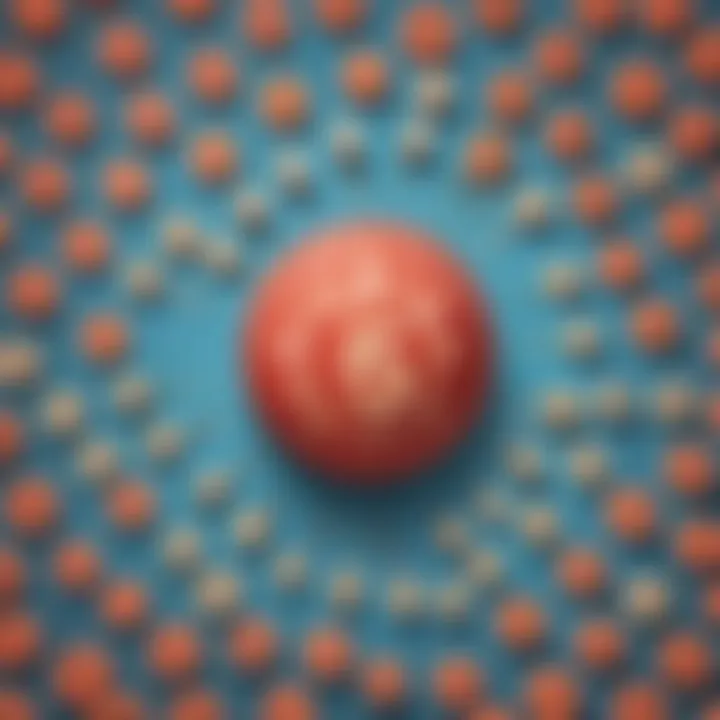Mastering the Art of Rounding Numbers Effectively


Intro
Rounding numbers is a skill that many of us use daily, often without even realizing it. It is not just about simplifying numbers; it's about crafting a clearer understanding of the world around us. When we round a number, we are making a choice about how to represent that number in a way that communicates meaning effectively. This article delves into why rounding matters, the principles behind it, and the various methods available to achieve it.
Consider this example: if I asked how many people attended a concert with an audience of 3,462, a quick answer often will be around 3,500. This way, we can easily grasp the size of the crowd without getting bogged down in specifics. Here, rounding demonstrates its value by enhancing communication and analysis.
By understanding the various rounding techniques, you can avoid common missteps and see how rounding plays a practical role in everyday life. From budgeting household expenses to interpreting statistics in news articles, mastering rounding is a stepping stone toward improved numeracy skills.
Prolusion to Rounding Numbers
Rounding numbers can appear as a straightforward concept on the surface, but its significance stretches far and wide in our daily lives. It’s about making numbers more manageable, which is crucial for comprehension and effective communication. Think about the last time you filled up your gas tank or calculated how much change you would receive at the register. In those moments, rounding helped simplify the numbers, turning potentially confusing figures into something that feels’ easier to tackle.
Defining Rounding
At its core, rounding is a method of adjusting a number to make it simpler while still being close to the original value. For instance, if you have the number 54 and wish to round it to the nearest ten, you would adjust it to 50 or 60, depending on whether you round down or up. Rounding helps in various applications, including mathematics, finance, and everyday tasks.
You might encounter different rounding techniques, such as rounding to the nearest whole number or rounding to decimals. Knowing how to round properly depends on understanding what place values are and how they function within the larger number structure.
The Importance of Rounding
Rounding plays a critical role in simplifying the mathematical landscape we navigate every day. It enables quick calculations, eases problem-solving, and aids us in comparing values more easily. Here are a few reasons why being proficient in rounding matters:
- Enhanced Clarity: Rounding reduces the complexity of numbers, making communication simpler. Nobody wants to squint at a long string of digits.
- Efficient Problem Solving: Quick estimates are vital to decision-making—whether you're figuring out what to tip at a restaurant or predicting how much money you will save over time.
- Everyday Relevance: From budgeting to crafting schedules, rounding wields its power in daily scenarios, making life just a bit less complicated.
Rounding is not only a mathematical skill but a life skill that empowers individuals to navigate the world with confidence.
In summary, understanding rounding numbers is foundational not only for achieving academic success but for everyday life. It enables individuals of all ages, whether students or seasoned adults, to approach numerical problems with confidence and clarity. Without mastering rounding, one may find themselves feeling slightly overwhelmed by the sheer scale of numbers that populate our daily routines.
Basic Principles of Rounding
Rounding numbers is about simplifying figures without losing the essence of the information they convey. It's a skill that can enhance clarity and efficiency in various calculations or discussions. Understanding the basic principles of rounding is essential, especially for elementary school children, parents, and caregivers. This foundational knowledge paves the way for effective math skills and helps in everyday decision-making.
Rounding Rules Overview
When it comes to rounding, rules serve as the backbone that guides the process. Here are a few core principles:
- Identifying the Place Value: The first step is knowing which digit you'll be focusing on. This could be anything from the ones to the thousands.
- Deciding Whether to Round Up or Down: If the digit to the right of your place value of interest is 5 or greater, you round up. If it's less than 5, you round down.
- The Goal: The overarching aim is to create a number that retains its value while being easier to work with. For example, rounding 47 to the nearest ten results in 50, while rounding 24 down to the nearest ten gives you 20.
Learning these rules is like having a roadmap through the world of numbers. It makes the journey smoother and less intimidating. The neatness of rounded numbers allows us to communicate complex ideas more clearly, especially when discussing big data or assessing financial situations.
Identifying Place Values
To round correctly, one must have a good grasp of place values. This is where a little attention goes a long way. Place values are like the address for each digit in a number, showing you where that digit fits in the grand scheme of things.
For instance, consider the number 3,764:
- The 7 is in the hundreds place.
- The 6 is in the tens place.
- The 4 is in the ones place.
When rounding, you want to focus on the digit immediately to the right of your target. Using our 3,764 example, if you're rounding to the nearest hundred:
- The 7 in the hundreds place looks at the 6 in the tens place.
- Since that 6 is five or more, the 7 rounds up to 8, moving the entire number to 3,800.
This grasp of position is crucial for understanding how and why rounding works. It sharpens numerical sense and helps children and parents alike develop a more intuitive relationship with numbers. Recognizing place value can mean the difference between solid understanding and confusion in mathematics.
"Understanding rounding not only enhances mathematical skills but also builds confidence in handling numbers daily."
By mastering these basic principles of rounding, readers can aid their children in developing essential math skills that will benefit them in school and beyond. This knowledge equips young learners to tackle more advanced concepts later on, making it a vital building block in the world of numeracy.
Remember, rounding doesn't have to be daunting or mysterious. With practice and a solid understanding of the rules and place values, numbers can become much more manageable.
Types of Rounding Methods
Understanding the various types of rounding methods is crucial for handling numerical data effectively. Each method serves a specific purpose and fits different scenarios, shaping how we simplify numbers without sacrificing accuracy. Recognizing the distinction between these methods gives both students and caregivers tools for practical applications, be it in the classroom or in daily life.
Round Half Up
Round half up is perhaps the most commonly seen method, especially in schools. The rule is straightforward: if a number ends in .5 or higher, you round up; if it's less than .5, you round down. For example, 2.5 becomes 3, while 2.4 rounds down to 2. This method is easy to grasp, making it a great starting point for young learners.
Pros:


- Simple and intuitive for elementary school students.
- Helps build a strong foundation in rounding concepts.
Cons:
- Can sometimes lead to bias in a statistical context, over-representing values that are exactly halfway.
Round Half Down
In contrast, round half down behaves differently when dealing with .5. With this technique, if the number is exactly half (like 2.5), it rounds down instead of up. So, according to this method, 2.5 would become 2, and 3.5 would turn into 3. This approach is less commonly taught, but it serves to illustrate the nuances in rounding methodologies.
Pros:
- Reduces the upward bias seen in round half up.
- Can teach the importance of decision-making in rounding.
Cons:
- May confuse young learners who are used to feeling more secure with round half up.
Round Up
Round up, also known as "ceiling rounding," is another method where all fractions lead to the next highest whole number. No matter what decimal follows, if the first whole number is needed, up you go. For instance, both 2.1 and 2.9 will round up to 3. This method has practical implications in situations where underestimating a quantity isn't an option, like budgeting or inventory counts.
Pros:
- Useful for financial calculations where precision is paramount.
- Ensures there are enough resources available if rounding applies to measure.
Cons:
- May lead to overestimations and financial inaccuracies if not managed carefully.
Round Down
Round down, or "floor rounding," goes the opposite way. Any fraction results in rounding down to the lower whole number. For example, 3.9 becomes 3, and 4.9 also rounds down to 4. This method is often useful in budgeting, where sticking to actual amounts instead of estimates keeps finances on track.
Pros:
- Helpful for maintaining safety margins in budgets or estimates.
- Avoids overcommitment of resources.
Cons:
- Can lead to severe underestimations in contexts requiring precision.
Bankers' Rounding
Bankers' rounding is a bit special. In typical cases of rounding where the value falls exactly halfway, it rounds to the nearest even number. Here's how it works: if you have 2.5, it rounds to 2; 3.5 rounds to 4. This method reduces bias when used in statistical data, especially when a larger dataset is involved.
Pros:
- Reduces the rounding bias observed in other standard methods, particularly useful in finance and statistics.
- Helps balance computations across datasets, lending itself to more accurate overall results.
Cons:
- May confuse beginners because it deviates from the established round half up rule.
Bankers' rounding is particularly beneficial in financial contexts to maintain accuracy with large datasets.
Recognizing these methods not only strengthens number skills among children but can also equip parents and caregivers with tools for guidance. Each rounding method has its unique benefits and drawbacks, making understanding them essential for a well-rounded mathematical education.
Practical Applications of Rounding
Rounding numbers, while often seen as a mere arithmetic trick, plays a significant role in many areas of life. Understanding how and when to use rounding not only helps in simplifying complex calculations, but it can also clarify communication in various fields. People appreciate numbers that are easier to digest. Instead of getting bogged down with precision, rounding provides a way to convey ideas smoothly. It’s not just about making numbers look cleaner; it’s about making information accessible at a glance.
A few key benefits of rounding include:
- Time-saving: In fast-paced environments, like financial markets or emergency services, quick estimations are critical.
- Clarity: Simplified numbers are often clearer to someone unfamiliar with the data.
- Better Decision-Making: Rounding can inform quicker, more effective choices in everyday scenarios.
"Sometimes, simplicity is the ultimate sophistication."
Everyday Rounding Scenarios
In our day-to-day life, rounding pops up more often than one might think. Let’s say a mother is budgeting for grocery shopping. Instead of writing down exact prices, she might just round them to the nearest dollar. This method saves time and mental overhead. Furthermore, rounding makes it easier to see how much she’s spending overall.


Other everyday scenarios might include:
- Timeliness: When you need to know how long till dinner, saying it’s approximately 30 minutes instead of 27 saves a few seconds in conversation.
- Cooking: Recipes often call for fractions of cups. Rounding helps cooks estimate without getting caught up in the minutiae of measurements.
- Distance Estimates: If someone asks how far away a store is, saying it's "just a mile or two" sounds simpler than rattling off exact measurements.
Rounding in Financial Contexts
When it comes to finances, rounding numbers becomes almost indispensable. Banks, accountants, and financial analysts use rounding to present figures cleanly. For instance, when you see your bank balance, the number is rounded to a more manageable figure rather than showing .86 cents or similar oddities.
In financial reports, rounding contributes to:
- Easier Reporting: Investors prefer clean figures. A revenue report indicating $1.5 million looks much neater than $1,487,550.
- Analyzing Trends: Looking at rounded figures simplifies spotting trends over time, which could guide investment decisions.
- Calculating Taxes: The rounding rules in tax calculations ensure compliance while making it simpler for taxpayers to navigate their responsibilities.
Rounding in Science and Engineering
In fields such as science and engineering, where precision is key, using rounding judiciously is crucial. Measurements can lead to extremely long decimal numbers. Yet, these fields still recognize the need to simplify for presentation. For example, when discussing measurements in a lab, a scientist might say a solution has a pH of 7 instead of saying it's 7.0035.
Consider the importance of rounding in engineering:
- Design Specifications: Often, engineers round measurements to the nearest thousandth; this helps in communicating tolerances effectively.
- Safety Standards: When dealing with weights, rounding can aid in ensuring specifications meet safety guidelines. A bolt designed for 100 pounds must be understood in practical terms, allowing for safe usages without excessive detail.
- Statistical Data: Scientists often round for ease when presenting results, helping audiences focus on the main takeaway without getting lost in the numbers.
Common Mistakes in Rounding
When it comes to rounding numbers, it’s easy to trip over some common errors if you’re not paying attention. Understanding these mistakes can be vital for both learning and teaching rounding concepts. Recognizing these pitfalls not only aids in enhancing numerical skills but also fosters a stronger comprehension of mathematics overall. From students grappling with homework to parents helping with assignments, being aware of these errors forms the groundwork for mastering rounding techniques.
Misunderstanding Place Values
A fundamental mistake many make originates from a lack of clarity about place values. For instance, consider the number 348.5. Students sometimes round this number to 350 instead of correctly rounding to 349. The misunderstanding arises from confusing the significance of digit positions. In this number, the digit '4' is in the tens place, while the '8' is in the ones place.
It’s crucial to realize that rounding involves looking at the digit immediately to the right of the identified place. So, when rounding to the nearest whole number, the '5' tells you to round up, making it 349. A simple way to reinforce this understanding is through visual aids, perhaps using place value charts or interactive games. Here is a small reminder:
"Knowing where a number sits in relation to others is half the battle in effective rounding!"
Ignoring Rounding Rules
Every math method comes with a guidebook of rules, and rounding is no exception. Ignoring these rules can lead to significant errors. Take the case of rounding numbers like 2.4 and 2.5. The established rule is straightforward: if the digit is below five, you round down, and if it's five or more, round up. However, some people round 2.4 to 2.5 because they see the '.4' and think it should be rounded to the next whole number.
In mathematical contexts, following these rules can be necessary for accuracy, especially in practical applications. It might be helpful for students to create a checklist of rounding rules to ensure they’re applying them correctly. This approach can also foster engagement and reduce the chance of mistakes by turning rounding rules into a game or fun project.
Inconsistent Rounding Approaches
Inconsistency in rounding methods often leads to confusion and errors. For instance, if someone consistently rounds up numbers during calculations but then rounds down for estimating, it may produce misleading totals. In this sense, it's not just about the correct method but also about consistency.
Using a uniform method eases understanding, whether in school assignments or financial calculations. For every context, be it educational or practical, having a standard approach helps in arriving at dependable answers. Students might find it effective to adopt one strategy across different scenarios, as this reinforces their learning and prevents mishaps.
- Establishing a uniform rounding approach can include:
- Selecting a primary method based on context (e.g., Round Half Up for general use).
- Sticking to one strategy helps in self-checking your work.
- Discussing strategies openly can reduce error rates in group settings, enhancing peer learning.
In sum, being aware of these common mistakes in rounding can not only improve individual math skills but also reinforce teaching techniques that can help students grasp these concepts more solidly. Understanding these aspects will lay a strong foundation for further mathematical learning.
Rounding Numbers in Education
Understanding how to round numbers is a cornerstone of mathematical education. It’s not just about making numbers easier to work with; it also helps in developing critical thinking skills. In classrooms, the teaching of rounding serves multiple purposes—students learn precision, improve their estimates, and grasp the concept of place value. These fundamentals are crucial as they lay the groundwork for more complex mathematical concepts down the line.
Teaching Rounding Techniques
When it comes to teaching rounding techniques, clarity and simplicity are paramount. The goal is to help students understand not just the ‘how’ but also the ‘why’ behind rounding. Here are a few effective methods that educators can use:
- Direct Instruction: Start with clear definitions and rules for rounding, such as rounding up when the digit is 5 or greater and rounding down when it is less.
- Visual Aids: Use number lines and charts to visually demonstrate how rounding works. This can help students see the relationship between numbers and where rounding takes place.
- Step-by-Step Examples: Walk students through problems step-by-step. For instance, take a number like 47 and show how to round it to the nearest ten by looking at the unit digit.
- Group Discussions: Encourage students to discuss their thought processes in small groups, helping them articulate their understanding and learn from one another.
- Real-Life Applications: Reinforce learning by showing how rounding is used in everyday scenarios. For instance, when shopping, prices often get rounded to the nearest dollar. Using relatable examples makes the concept stick.
By employing these techniques, educators create a robust foundation for students to build upon.
Engaging Activities for Students
Making rounding fun is key to retention and understanding. Engaging activities can enrich the learning experience and foster enthusiasm. Here are some creative ideas:
- Rounding Relay Race: Divide the class into teams and set up a relay race where each student has to round a number correctly before passing the baton to the next teammate. It builds teamwork while reinforcing skills.
- Rounding Bingo: Create bingo cards with various rounded numbers and call out decimals for students to round. This game adds an interactive twist that keeps students engaged.
- Make Your Own Number: Have students create their own “rounding charts” at home based on favorite numbers, like sports stats or game scores. They can present their findings, which develops both their analytical and presentation skills.
- Round the Room: Place large numbers around the classroom. Students must walk around and round them correctly. Adding a physical element enhances memory retention.
- Online Games: Recommend websites that specialize in math games focused on rounding. These can be a great way to supplement classroom learning in a fun way.
Engaging students in fun activities not only aids in learning but makes the numbers come alive for them, turning abstract concepts into tangible experiences.


Utilizing a mix of these engagement strategies keeps students interested and encourages them to practice their rounding skills in enjoyable ways. With a solid understanding of rounding techniques and creative learning activities, students will surely excel in their mathematical capabilities, paving the way for future success.
Advanced Rounding Concepts
Rounding numbers might seem like a straightforward topic, but diving into advanced concepts reveals layers of complexity and nuance. Understanding these advanced rounding concepts is crucial, as they enhance numerical precision and decision-making in various fields. A firm grasp allows individuals, especially students, to better interpret data, which is beneficial in both academic and everyday settings.
Understanding Significant Figures
Significant figures are key when it comes to rounding in scientific contexts. They represent the digits in a number that contribute to its accuracy. This means not just counting all figures but knowing which ones matter based on their position. For example, in the number 0.00456, the significant figures are the 4, 5, and 6, as the leading zeros don't contribute to value.
When rounding numbers, it's important to know how to maintain the integrity of these significant figures. This is especially critical in fields like chemistry and physics, where measurements can influence results and conclusions. Using significant figures helps to communicate how precise a measurement is, which is valuable for both reporting data and comparing results.
Some quick rules to remember include:
- Non-zero digits are always significant.
- Leading zeros (0s to the left of the first non-zero number) are not significant.
- Captive zeros (0s between significant digits) are significant.
- Trailing zeros in a decimal number are significant, but without a decimal point, as in 1500, they could be ambiguous.
Using Rounding in Statistical Analysis
Rounding plays a vital role in statistical analysis, where precise data is essential but sometimes impractical to manage in its raw form. Researchers often deal with massive datasets, and rounding helps condense information, making it easier to analyze and present.
For instance, when calculating averages or medians from a dataset, rounding to an appropriate number of decimal places helps communicate results more clearly, without overwhelming the audience with excessive detail.
When rounding in statistics, it's also critical to consider the potential for bias. Depending on how numbers are rounded, you can inadvertently skew results. Understanding advanced concepts like these is essential for accurate statistical reasoning.
Here is a practical example: if you analyze the test scores of a class and find that the average score is 74.56, rounding to two decimal places can be useful, but if rounded up to 75 can mislead the perception of how the class performed overall. Clear communication about how numbers have been rounded is just as important as the rounding itself, preserving the essence of the analysis.
In summary, mastering advanced rounding concepts not only clarifies data interpretation but also enhances the efficacy of decision-making across various disciplines.
Rounding in Different Number Systems
Rounding plays a crucial role in various number systems, helping to streamline calculations and enhance the ease of comprehension. Different systems—such as decimal, binary, and hexadecimal—may apply their own nuances to the rounding process. Understanding these distinctions is key, especially for learners and practitioners who deal with multiple numerical forms. This section will delve into the specifics of rounding in different number systems, highlighting benefits and considerations that can affect accuracy and efficiency in computations.
Decimal Rounding
Decimal rounding is what most people are familiar with, as it’s the standard system we use in daily life. When rounding decimal numbers, we typically follow rules around place values: hundreds, tens, ones, tenths, and so on. This system simplifies calculations, but it’s important to grasp how and when to apply rounding effectively.
For instance, rounding the number 3.678 to one decimal place requires checking the second decimal place—7 in this case. Since it’s 5 or more, you round up, giving you 3.7. Consider this list of important aspects:
- Precision: Decimal rounding maintains a level of precision while delivering a more digestible number.
- Application: Common in financial contexts, like receipts or budget calculations.
- Limitations: Over-reliance can lead to loss of accuracy, particularly in scientific measurements.
Understanding decimal rounding not only helps in everyday tasks but also sets a solid foundation for tackling more complicated number systems.
Binary and Hexadecimal Rounding
When we step into binary or hexadecimal systems, rounding gets a bit more intricate. These systems are often used in computing and programming.
Binary Rounding: In binary, numbers are represented using only two digits: 0 and 1. Rounding can be performed similarly to the decimal system, but we’re typically focusing on bits. For example, if we have the binary number 101.1101 and want to round to three bits after the decimal, we look at the fourth bit: 1. Since it’s 1, we round up to 110.000. Essentially:
- Bit manipulation: Understanding how to shift bits properly is essential for accuracy.
- Usage: Often applies in computer algorithms when precision is needed in data processing.
Hexadecimal Rounding: Hexadecimal uses sixteen symbols (0-9 and A-F). Rounding here also considers place values. When rounding a hexadecimal number, say 1A.4C to one digit after the decimal, you would look to the next value (4) to decide on rounding. If necessary, applying rounding principles means converting back to binary or decimal for use.
- Complexity: Adding layers of variable representations increases complexity.
- Performance: Critical in programming where performance can hinge on the exactness of calculations.
To sum up, rounding in these number systems requires not just an understanding of basic principles but also an appreciation for how they influence computational tasks. Knowing when and how to round effectively ensures that calculations remain both manageable and reliable.
"In numeracy, adaptation to different systems is critical for clarity and precision, especially in fields like programming or data analysis."
By tuning into the unique demands of each number system, one can gain a more rounded view of mathematics as a whole.
Closure
Rounding numbers plays a crucial role across various domains of life, whether in the classroom, at home, or in professional settings. The ability to round effectively allows individuals to present information clearly, simplifying complex data into more digestible pieces. It eases the burden of mental calculations and enhances communication concerning numerical values. The understanding of rounding isn't just about the mechanics of math; it also opens up a broader conversation about numerical literacy in today’s data-driven world.
Recapping Key Points on Rounding
To ensure the essence of rounding is not lost along the way, let’s revisit the key points discussed in this guide:
- Defining Rounding: At its core, rounding is about adjusting numbers to their nearest place value, which simplifies calculations and makes figures more accessible.
- The Importance of Rounding: Emphasizing its value in everyday settings helps to appreciate its necessity in conveying clarity and precision in numeric data.
- Types of Rounding Methods: Different approaches like Round Half Up, Round Half Down, Round Up, and Round Down cater to various needs, proving rounding isn't a one-size-fits-all endeavor.
- Common Mistakes in Rounding: Awareness of missteps, such as misjudging place values and inconsistent methods, can largely improve rounding accuracy.
- Practical Applications: From financial reports to scientific calculations, rounding behaves as a tool for efficiency and understanding in numerous contexts.
Encouragement for Further Exploration
As we wrap up this discussion, it's important to encourage further exploration into the world of numbers and rounding. Whether you’re a parent looking to aid your child’s comprehension or someone eager to refine your own skills, there are always avenues to deepen your understanding. Here are a few ways to broaden your grasp on the topic:
- Engage in Real-Life Activities: Encourage children to practice rounding numbers in everyday situations, like shopping or cooking, where precision is necessary.
- Explore Resources: Use platforms like Wikipedia for definitions or discussions on rounding's applications in different fields.
- Interactive Learning: Participate in forums, such as those found on Reddit, where discussions about math methods and techniques occur regularly.
- Experiment with Technology: Familiarize yourself with rounding applications in software and apps to see how technology handles these mathematical tasks.
By seeking out more information and practice opportunities, you not only reinforce your understanding of rounding but also foster a lifelong appreciation for mathematics.







